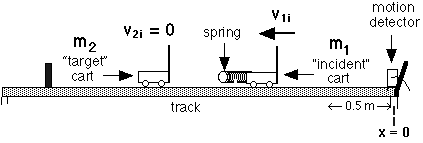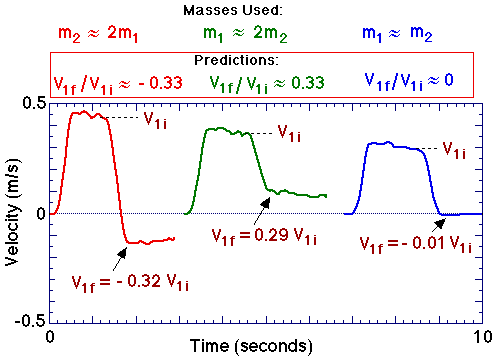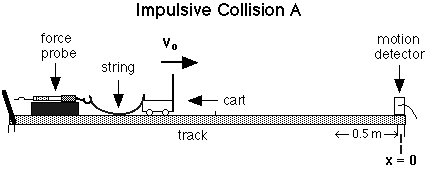Physics 211 Lab #5:
Collisions
Key Activities:
 Nearly Elastic
Collisions
Nearly Elastic
Collisions
The first activity will involve studying nearly elastic collisions
(Lectures 15,
16)
including a "no-contact" collision (via magnetic repulsion) between a cart
and a barrier (Collision A).


Using a motion detector, the velocity (top),
momentum (middle), and kinetic energy (bottom) of the cart is studied
before, during, and after the collision (in this case, Collision A). An
analysis of this data shows that this collision exhibits a roughly 10%
loss of kinetic energy due to the collision. This energy is primarily
lost to the barrier due to the "recoil" motion of the barrier during the
collision.


An elastic collision between a moving "incident" cart
and a stationary "target" cart will also be studied. The ratio between
the "incident" cart's final and initial velocities,
v1f/v1i, will be studied as a function of the
"incident" and "target" cart's masses. In an ideal elastic collision, in
which momentum is conserved and the relative velocity between the two
carts is unchanged by the collision, one expects
v1f/v1i = (m1 -
m2)/(m1 + m2).
 Impulsive
Collisions
Impulsive
Collisions
In this activity, different impulsive forces and their
relationship to momentum change will be investigated (Lecture
16).


 Using a motion detector and a force probe, the force vs.
time profile of different impulsive forces will be measured, integrated,
then compared to the observed change in the cart's momentum. The left
pair of force and momentum plots correspond to the impulse generated with
the string alone (Impulse A), while the right pair correspond to the
impulse generated when a spring is added (Impulse B). Both impulse
experiments demonstrate (a) the equivalence between the change in
momentum, pf - pi, and the impulse, I (= area
under the F(t) curve), and (b) the insensitivity of this equivalence
to the shape of the F(t) curve.
Using a motion detector and a force probe, the force vs.
time profile of different impulsive forces will be measured, integrated,
then compared to the observed change in the cart's momentum. The left
pair of force and momentum plots correspond to the impulse generated with
the string alone (Impulse A), while the right pair correspond to the
impulse generated when a spring is added (Impulse B). Both impulse
experiments demonstrate (a) the equivalence between the change in
momentum, pf - pi, and the impulse, I (= area
under the F(t) curve), and (b) the insensitivity of this equivalence
to the shape of the F(t) curve.
 Inelastic
Collisions
Inelastic
Collisions

The change in cart momentum and kinetic energy
through a completely inelastic collision with another cart will also be
investigated (Lecture
14).

The data shown illustrates the approximate conservation
of momentum before and after the perfectly inelastic collision,
(Pfinal-Pinit)/Pinit = -0.02, and the
substantial loss of kinetic energy,
(K.E.final-K.E.init)/K.E.init = -0.52.
The latter result compares well with that expected in a completely
inelastic collision,
(K.E.final-K.E.init)/K.E.init =
-m2/(m1 + m2) = -0.5.








